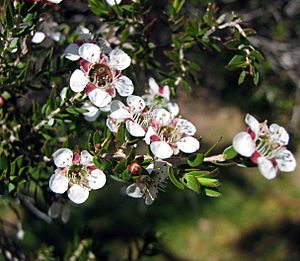Leptospermum novae-angliae facts for kids
Quick facts for kids Leptospermum novae-angliae |
|
|---|---|
 |
|
| Leptospermum novae-angliae in the ANBG | |
| Scientific classification | |
| Genus: |
Leptospermum
|
| Species: |
novae-angliae
|
The New England Tea-tree (Leptospermum novae-angliae) is a type of shrub that grows only in eastern Australia. This means it's endemic to that area – you won't find it naturally anywhere else! It has special leaves that are often close together, and pretty white flowers that grow by themselves on short branches. Its fruit stays on the plant even after it's ripe, until the plant eventually dies. You'll usually find this tea-tree growing in rocky areas.
Contents
What Does the New England Tea-Tree Look Like?
The New England Tea-tree is a shrub that can grow up to 2 m (6 ft 7 in) (about 6.5 feet) tall. Its older branches have bark that peels off in flakes. When the stems are young, they feel soft and hairy, but as they get older, they become smooth.
Leaves and Flowers
The leaves of this tea-tree are usually packed closely together. They are shaped like an oval, from 5–15 mm (0.20–0.59 in) long and 1–4 mm (0.039–0.157 in) wide. They narrow down to a short, wide stalk called a petiole.
The flowers are white and grow by themselves at the ends of small side branches. These branches keep growing even after the flowers bloom! Each flower is about 10–12 mm (0.39–0.47 in) (about half an inch) wide. At the bottom of the flower bud, and sometimes even on the open flower, you might see small reddish-brown parts called bracts.
The part of the flower that holds the petals and other parts, called the floral cup, is smooth and about 4 mm (0.16 in) long. It has tiny, clear bumps called glands on it. The sepals (small leaf-like parts that protect the bud) are egg-shaped and about 2.5 mm (0.098 in) long. The white petals are about 5 mm (0.20 in) long, and the stamens (the parts that make pollen) are 2.5–4 mm (0.098–0.157 in) long.
When Does it Bloom?
This tea-tree mostly blooms from October to November. After flowering, it produces a fruit called a capsule. These capsules can be different sizes, from 5–12 mm (0.20–0.47 in) across. What's interesting is that these fruits stay on the plant until the plant itself dies!
How Was This Plant Named?
The New England Tea-tree was first officially described in 1989 by a botanist named Joy Thompson. She wrote about it in a science journal called Telopea. The plant material she used to describe it was collected in 1962 by Ernest Francis Constable near Bald Rock, close to Tenterfield.
The second part of its scientific name, novae-angliae, refers to the New England Tableland. This is a high area in New South Wales, Australia, where this plant is found.
Where Does the New England Tea-Tree Grow?
This special tea-tree likes to grow in rocky places. You can find it in open shrubland (called heath) and forests, especially on granite rock formations. It grows on the New England Tableland and nearby areas of the Western Slopes in New South Wales. It also grows in south-eastern Queensland, stretching north from a place called Point Lookout.
Is This Plant in Danger?
Good news! The New England Tea-tree is not considered to be in danger. The Queensland Government has classified it as being of "least concern" under their Nature Conservation Act 1992. This means there are plenty of them around, and they are not currently at risk of disappearing.

